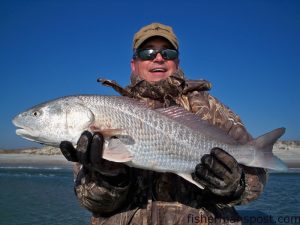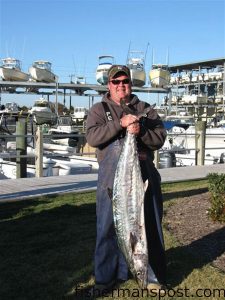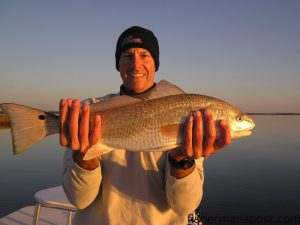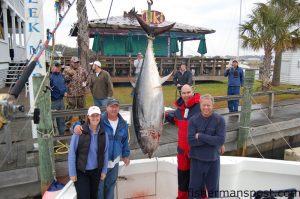Swansboro Winter 2009

Rob Prewitt, of Holden Beach, with a 10 lb. redfish he landed while fishing with Capt. Jeff Cronk, of FishN4Life Charters out of Swansboro.
Jeff, of FishN4Life Charters, reports that the inshore water temperature fell fast early in the month, forcing the speckled trout and red drum into their winter patterns.
The drum are schooled up on the sand flats and shoals near Bogue Inlet (some schools of 2,000+ fish). Anglers can catch them by fishing scented soft plastic baits. The colder the water gets, the slower anglers should work the baits.
While the redfishing is exciting, it occurs right in the surf zone and can be very dangerous, so anglers should try it out with a guide before attempting to chase the fish from their own boats.
Speckled trout are schooling around the jetties along the coast and near deep structure in the inlets. The creeks off the ICW and sound are holding a lot of small trout mixed in with some larger (2-5+ lbs.) fish. Anglers should fish mild weather days with small, light baits for the best results. Paddle tail grubs are especially effective.
A mix of trout, small reds, small flounder, and a few stripers are feeding in creeks off of the rivers. Suspending lures like the Rapala Subwalk and X-Rap are effective at targeting the larger trout. Artificial shrimp like 3″ Gulps, 3″ Storms (pink), and Billy Bay Halo shrimp are also good choices.
On calm weather days, anglers should be able to run to structure just 3-5 miles off the beaches and hook up with sea bass and other bottom feeders on bottom rigs baited with squid or cut baits.
Big striped bass will be feeding on Cape Lookout Shoals if the water gets cool enough this winter, which won’t take long if the hard cold snaps continue.
Rob, of Sandbar Safari Charters, reports that red drum are schooled up along the beaches of Bear and Browns Islands, and they should be there through February. Gulp pogies and flukes are producing plenty of strikes from the reds, which will get more sluggish as the water cools.
The speckled trout bite has been very good in the rivers and the Hwy. 24 creeks and residential creeks. Gulp and Powerbait shrimp imitations are the best trout producers over the winter. Anglers can also find schools of trout by running the beaches on calm days and looking for surface disturbances or trolling MirrOlures down the beaches.
Both the trout and reds will slow down as the water cools, but anglers can still put together some solid fishing days over the winter by choosing sunny days with morning temperatures in the 40’s or better. Stealth, slow, and realistic presentations are key during the winter months, as the fish aren’t as hungry and are already in a defensive mode in the cold, clear water.
Off the beaches, structure in the 5-15 mile range should produce action with false albacore, sea bass, and some gag grouper (most small with a few keepers thrown in) over the winter.

Hunter Beach (age 7), of Clayton, NC, with his first red drum. It was caught on a live finger mullet on the Bogue Inlet shoals while fishing with Capt. Rob Koraly of Sandbar Safari Charters out of Swansboro.
Jamey, of Coastal Carolina Charters, reports that bluefin tuna have shown up, and so have plenty of boats chasing them. Anglers who are new to the fishery should consider taking a charter (often available very cheaply), as the fishing can be extremely dangerous for the inexperienced.
The Gulf Steam is also productive this time of year, and boats making the run there should be able to find some dolphin and big wahoo. Trolling dead cigar minnows or ballyhoo behind a Pirate Plug or Blue Water Candy Witch is the best bet in the bluewater. Starting at the Big Rock and working down to the Yellowfin Hole is a good way to find the fish.
Striped bass should make it down to Cape Lookout this winter (if the water cools enough). If and/or when they show, trolling Mojo Rigs, Stretch 25’s, and Yo-Zuri Magnums around diving birds will put them in the boat. If the fish are feeding on the surface, topwater plugs like MirrOlure Top Dogs and Yo-Zuri Hydro Pencils will also do some damage.
Stan, of Capt. Stanman’s Charters, reports that bluefin tuna have shown up in the area, and last week they were feeding on the East Beach in 35′ and at the East Rock and 210 Rock. This may be the best winter in the last few years for the giant tunas, and it’s all because of cold water and plenty of bait.
The cold water is also moving big schools of pogies down the beaches towards the area, and striped bass will follow them to Cape Lookout if it stays cold. The bite could get started as early as Christmas and last through the second or third week in January.
Bottom fishermen are hooking good number of grouper 30-35 miles off the inlet, but it will all come to a close when the federal government shuts down the fishery on January 1.

Gary Norris with a 44 lb. king caught on live bait running up to Hatteras out of Morehead City. He was fishing with Frank Eastman on Frank
Dale, of The Reel Outdoors, reports that the giant bluefin tuna have arrived.
There’s been a solid grouper bite 40-50 miles offshore, where boats are loading up on some fat reds and scamps on dead cigar minnows.
Inshore, the speckled trout bite is slowing down, but anglers are catching some trout and red drum back in the creeks where they can find slightly warmer water. Shrimp and a variety of artificials will tempt both fish to strike.







